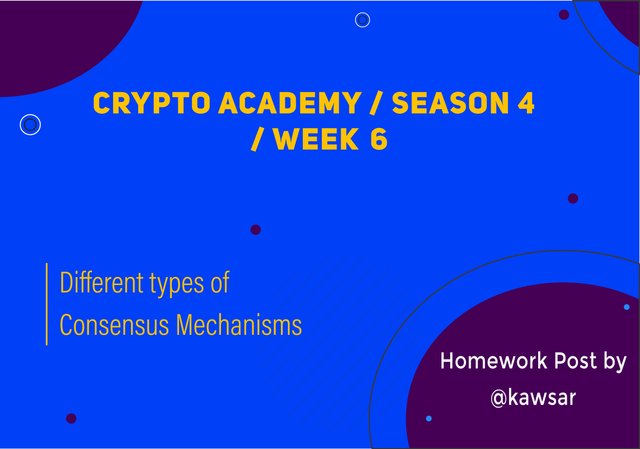Today I will post my homework in Season 4 Task 6, today the topic of homework was Different types of Consensus Mechanisms. In today's homework task I will answer question 1.

Question: (1)
What is the difference between PoW & PoS? Advantages & Disadvantages? Which one is better in scaling Capacity? Examples?
What is the difference between PoW & PoS?
PoW:
PoW or Proof of Work is a consensual mechanism through which miners solve complex mathematical cryptographic problems. This is to prove the work and to do it requires a lot of computing effort and a lot of power consumption. As a result, no one in the blockchain can change or allow it to change. This allows us to complete the transaction in a completely secure manner in a completely decentralized manner so that we can complete the peer-to-peer transaction through this system without any third party intervention. All of these records are stored in a laser in the blockchain in the form of a hash. Minors are rewarded for solving this difficult mathematical problem, for successfully creating a block. It is almost impossible to change or delete blockchain transactions in a group of work systems.
One thing we do know is that cryptocurrency has a thing called double spending, meaning that a person can use the same resource twice if he wants to. And many users can be deceived by this double spending. Suppose a person has a bitcoin. And one thing we do know is that a Bitcoin transaction takes 10 minutes to complete. In that case if that person sends that one bitcoin to two people, then those two people will receive bitcoin but it will show pending and the transaction of those two people will start working for 2 miner mining. Whose transaction will be completed earlier, his transaction will be successful and the rest of the transaction will fail. Mining is very effective in solving this problem.
PoS:
Proof of stake is used to verify transactions. This system allows a user to hold a cryptocurrency. Block verification is based on the number of tokens a person has. The more tokens there are, the more valuable they are. This is in contrast to the proof of work system, the validator section is operated.
It serves as an alternative to proof of work. It has higher strength than proof of work. Because like proof of work, strong computer power is not required here or high power power is not required. Proof of steak The transaction can be completed much faster and its scalability is much better. For those who want to invest in cryptocurrency, it is important to know about this proof of stake.
Proof of Stack allows a user to have a lockup when their tokens are stocked and allows the user to create a validator node after stocking the coins. They can be unlocked again when the user wants to make a transaction.
Difference between PoW & PoS:
| PoW | PoS |
|---|---|
| This requires high computing power. | PoS does not require to high computing power. |
| They solve complex cryptographic mathematical problems. | They are very easy to stake tokens. |
| Lots of electrical energy is required | Lots of electricity is not required. |
| It is very expensive. | Much less expensive than Proof of Work. |
| It is decentralized | It is Centralized. |
| Security is much higher in terms of hacking | Security is low in terms of hacking. |
| Its process is by minor | Its process is by validator. |
| Miner Get rewards create blocks. | validators get rewarded with transaction fee. |
Advantages & Disadvantages?
PoW:
Advantages
- Its transaction fee is much lower.
- Peer-to-peer transactions can be completed directly without any third party intervention.
- There is no need to do Know Your Customer (KYC) verification.
- Since it is decentralized, a user has complete interference in his wallet.
- There is a difficult mathematical process to solve the problem of double spending.
- In the case of hacking, its security level is much higher.
Disadvantages
- It is very expensive.
- Its transaction speed is very slow.
- This requires higher computing power.
- It costs a lot to operate.
PoS:
Advantages
- Its scalability is much higher, Can complete many transactions at once.
- It requires much less energy for maintenance.
- it can complete transactions very quickly.
- It does not require much high power.
Disadvantages
- The commission of the transaction is high.
- Stake coins take long time to get back.
- Those who have more coins are more influential and those who are less have less influence or value.
- It has less security for hacking.
Which one is better in scaling Capacity? Examples?
Above I have briefly described the whole of War and Fruit of Steak, the differences between them, their advantages and their disadvantages. Scalability is a matter of how many transactions can be made in a very short period of time. We can say that this method has a lot of scalability as it has the ability to transact a lot in a very short time. Because this method can complete a lot of transactions in a very short time or at a certain time. In that case, we can deduce from the above discussion that Proof of Stake can complete many transactions in a much shorter time, using very little energy, compared to Proof of Work.
Example:
tezos is a blockchain of a decentralized nature. It uses open source technology. Using the proof of stake method.
